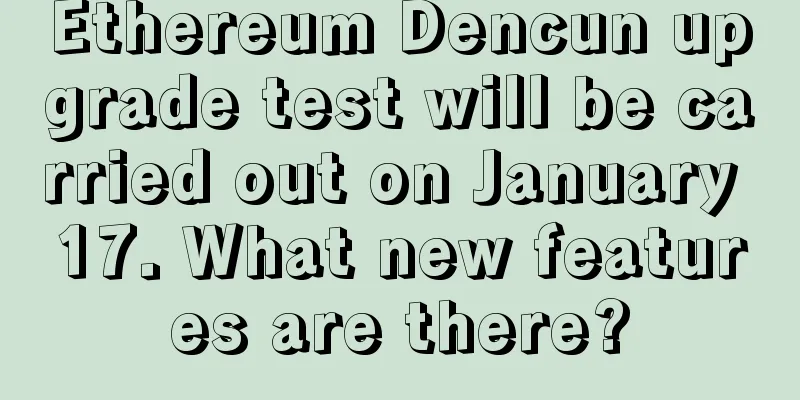Ethereum Dencun upgrade test will be carried out on January 17. What new features are there?

|
Ethereum’s upcoming upgrade “Cancun-Deneb” (also known as “Dencun”) will begin testing on January 17 , according to a notice posted on the official Ethereum GitHub repository. The upgrade will first be applied to the Goerli test network, then added to Sepolia on January 30 and Holesky on February 7. The Ethereum team has not yet announced a specific date when Dencun will be implemented on the main network. The new upgrade includes several tools designed to reduce fees, allow new features for bridges and stake pools, and limit self-destruct operations on smart contracts. According to its development documentation, Dencun will include Ethereum Improvement Proposal (EIP) 4844, also known as "proto-danksharding". This will allow Layer-2 Rollup networks (such as Arbitrum, Base, Polygon zkEVM, etc.) to temporarily store specific transaction data using a new format called "blobs". Blobs can be deleted after 18 days, while the current practice is to include data in the "CALLDATA" field and save it permanently on the blockchain. Ethereum developers believe that proto-danksharding will significantly reduce transaction fees on Layer 2. The upgrade also includes several other proposals, including EIP-1153, which introduces a "temporary storage" system to further reduce fees, and EIP-4788, which improves transparency by storing the root of each beacon chain block in a smart contract that can be queried by applications. Developers expect the data provided by EIP-4788 to be used for new features for bridges and staking pools. Additionally, Dencun includes EIP-6780, a proposal to restrict the use of the self-destruct keyword. If embedded in a contract before deployment, self-destruct can currently be used to erase a smart contract's code and send all its funds to the account that deployed it. After Dencun, the keyword will not erase the code unless it is called in the same transaction as the deployment. However, even if the keyword is called in a future transaction, it will still transfer all funds to the deployer. Ethereum upgrades are typically tested for months before being deployed to the main network. The last deployment, codenamed “Shapella,” began testing on February 7. It was launched to the main network on April 12. |
<<: What supports Solana's soaring price?
Recommend
What does a short little finger mean for a man?
What does a man's short little finger mean? A...
What are the facial features of a woman who cannot give birth to a boy?
It is said that children are the bond of a family...
What are the facial features of lower sclera?
In fact, sometimes, although our eyes look simila...
Illustration of the cheating line on men's palm
Illustration of the cheating line on men's pa...
How is your life fortune according to Zhouyi palmistry?
How is your life fortune according to Zhouyi palm...
Is it good for a woman to have a mole on her instep?
Everyone has some moles more or less. What do the...
Palmistry Analysis: How to tell a person's personality from the love line
Everyone has his or her own personality, and ever...
Bitfinex uses company equity to compensate customers for losses
Rage Comment : At the beginning of the month, the...
Facial features of people who are good at taking shortcuts
Although there are indeed shortcuts to some thing...
How to see personality and destiny from nasolabial lines and lips
The nasolabial folds are the two symmetrical line...
Australian blockchain firm finalizes $190 million cryptocurrency mining deal
Sydney-based IoT Group, a publicly traded company...
Three Hangzhou network administrators were arrested for implanting a "mining" virus into Internet cafe computers
According to Tencent Technology, on July 31 this ...
Mediachain’s grand vision: creating a blockchain-based artwork identification tool
Mediachain is a company that envisions using a bl...
Altcoin exchange ShapeShift raises $1.6 million in new funding
Digital currency exchange ShapeShift.io has raise...
The face of the woman that diamond men most want to marry
The face of the woman that diamond men most want ...









